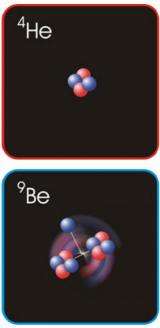Proton's party pals may alter its internal structure

A recent experiment at the DOE's Thomas Jefferson National Accelerator Facility has found that a proton's nearest neighbors in the nucleus of the atom may modify the proton's internal structure.
The result was published in the November 13 issue of the journal Physical Review Letters.
When comparing large nuclei to small nuclei, past measurements have shown a clear difference in how the proton's constituent particles, called quarks, are distributed. This difference is called the EMC Effect.
Many models of the EMC Effect predict that it is caused by the mass or density of the nucleus in which the proton resides. To test these predictions, experimenters made precise new measurements of the EMC effect in a variety of light nuclei, such as isotopes of helium.
"What we found is that there is a large modification of the quark structure in helium-4, and there was a much smaller effect in helium-3. And even though they were both light nuclei, they had a very different EMC Effect," said John Arrington, a spokesperson for the experiment and a nuclear physicist at DOE's Argonne National Lab.
The results, Arrington added, rules out the idea that the size of the EMC effect scales with the mass of the nucleus.
Next, the experimenters turned their attention to density. They compared the EMC Effect in beryllium to various other nuclei. Beryllium has a mass similar to carbon but a much lower density, roughly the same as helium-3. They found that the size of the EMC Effect in beryllium is similar to that of carbon, which is twice as dense.
"So you have one set of data that tells you the mass-dependence picture doesn't work and another that tells you the density-dependence picture doesn't work," Arrington explained. "So, if both of these pictures are wrong, what's really going on?"
Interestingly, the result did indicate a possible new cause for the effect: the microscopic structure of nuclei. This possible result is hinged on the unusual structure of beryllium. Most of the time, beryllium's configuration consists of two orbiting clusters that look like helium-4 nuclei (each with two protons and two neutrons), and one additional neutron orbiting around.
The orbiting clusters yield a large radius and a low average density for the beryllium nucleus, but most protons and neutrons are contained within the high local densities of the clusters. This suggests that the EMC effect may be entirely generated within these small, high-density clusters.
"That's a hypothesis, but it's certainly clear that it's small groups of nucleons that get together and change things, rather than the whole collection," Arrington said. "In a way, it's not really surprising. If you're at a party, it doesn't matter how many people are in the room, most of the time you're interacting with the people that you're closest to."
Arrington says the next step is to take a new measurement that directly examines the impact of the local density. This can be done by looking at the quark structure of the deuteron, a nucleus consisting of just one proton and one neutron. Most of the time, the proton and neutron are pretty far apart.
"We want to isolate the quark structure during the moment when the proton and neutron are very close together. If we find a large effect in such a small and simple nucleus by looking when the proton and neutron are closest together, it will demonstrate that the EMC effect does not require a large, dense nucleus - it simply requires two nucleons coming into extremely close contact," Arrington explained.
The experiment, E03-103, ran for 21 days in Hall C in October of 2004. It measured the momenta of protons knocked out of the nuclei of hydrogen, helium, beryllium and carbon atoms by electrons from the CEBAF Accelerator.
Source: Thomas Jefferson National Accelerator Facility

















